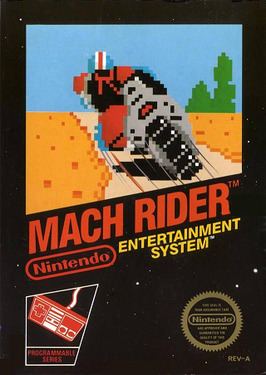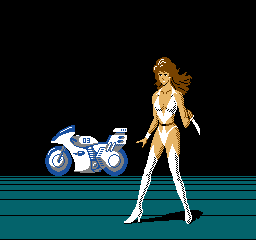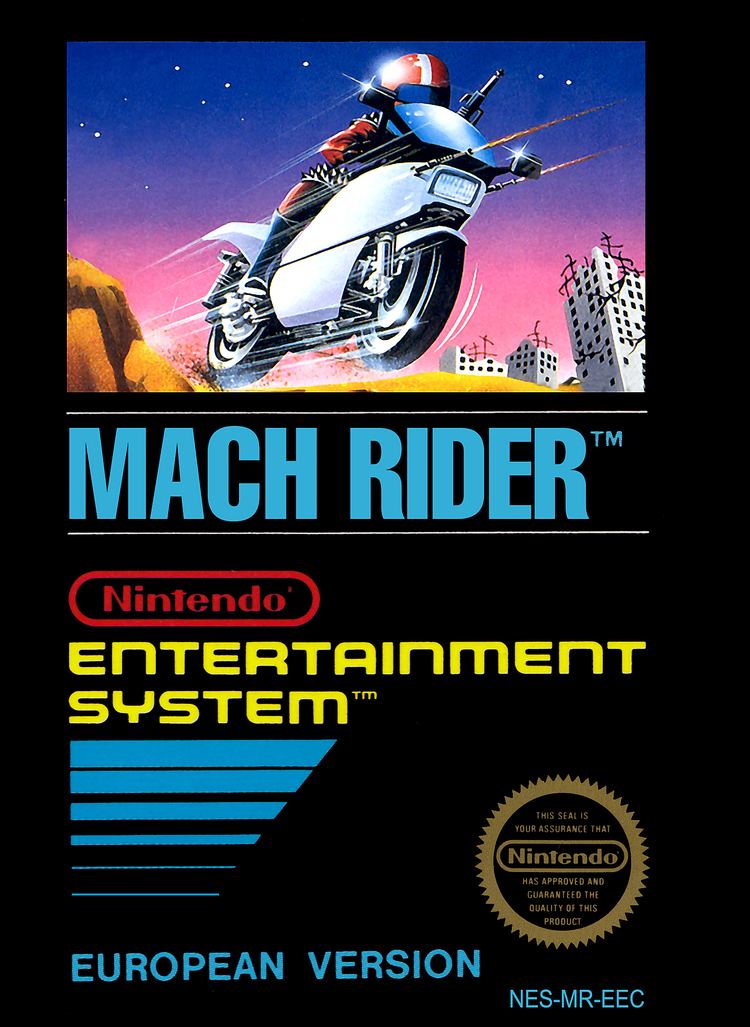8.6 /10 1 Votes8.6
Initial release date 18 October 1985 Genre Racing video game | 4.3/5 Emuparadise | |||||||||||||||||||||||||||||||||
 | ||||||||||||||||||||||||||||||||||
Composer(s) Hideki Kanazashi, Hiroaki Suga Similar Clu Clu Land, Devil World, Joy Mech Fight, Binary Land, Wrecking Crew | ||||||||||||||||||||||||||||||||||
Mach Rider (マッハライダー, Mahha Raidā) is a futuristic driving video game created by Nintendo. It was first released on October 18, 1985 for the Nintendo Entertainment System in North America and November 21, 1985 in Japan. On March 15, 1987 it was released in Europe and Australia. The Famicom version can use the Famicom Data Recorder to save custom tracks.
Contents

It was released on the Virtual Console for the Wii (2007), Nintendo 3DS (2013) and Wii U (2014). While the feature was only available in the Famicom version in the original releases, all versions of the Virtual Console release except for the 3DS version can save custom tracks.

Gameplay

The game's controls are somewhat more complex than other games at its time and require some extra skills. The left and right directions on the Control Pad steer Mach Rider and the A button accelerates. The B button fires Mach Rider's machine gun which can be used to destroy enemies and obstacles on the road. The up and down buttons are used to shift gears. Mach Rider's bike has four speed and shifting to the fourth gear at high speed will grant the player in instant speed boost. Conversely, if the player remain in higher gear while stopping results to a slower acceleration.
In each round, points can be scored by destroying enemies and certain obstacles with the machine gun. The number of points scored for destroying enemies and obstacles are determined by the power of the enemy destroyed and the type of obstacle destroyed. If the player "blocks" an attacking enemy by ramming it against a hazard on the track, they obtain more points, and this also replenishes Mach Rider's bullets.
Plot
Mach Rider takes place in the year 2112, and planet Earth has been invaded by evil forces driving vehicles known as Quadrunners. The player controls Mach Rider, who travels from sector to sector on a high-powered superbike, searching for survivors and destroying any enemies in his path.
Legacy
Back in 1972, Mach Rider was originally released as a plastic race car or hot rod toy also by Nintendo that came with a ramp for jumping and a stick shift-like object with three different kinds of meters on it. When the car is placed inside of it, it can be charged up and let loose at high speed.
Later, Mach Rider was released as part of the Nintendo Vs. Series arcade variations. It was essentially a modified version of the Endurance Course from the original game. Each time the player completed a level, a bit more of an image was gradually revealed of a woman with a dagger appears next to Mach Rider's bike.
While Mach Rider has not gained a true sequel, many elements from the game, such as the futuristic setting, incredible high speeds and aggressive racing have also been used in Nintendo's premiere racing series F-Zero, making it somewhat of a spiritual sequel to Mach Rider. Even the character Mach Rider herself bears some similarity to the hero of the F-Zero series, Captain Falcon.
In the Super Smash Bros. series there were some Mach Rider references. Starting with Super Smash Bros. Melee, Nintendo's crossover fighting game has a remix medley of the Mach Rider soundtrack, including the title screen music, track selection music, stage music and game over jingle. This music is used as alternate music on the F-Zero themed stage called Big Blue, further reinforcing the connection between the two series. There is a Trophy of Mach Rider that can be earned, which shows Mach Rider in great detail on his motorcycle.
In Super Smash Bros. Brawl, the Mach Rider became one of the game's many Stickers, while the remix medley from Super Smash Bros. Melee returned, only this time to the F-Zero-themed stage, "Port Town: Aero Dive", rather than Big Blue.
In Mario Kart Wii, a vehicle called the "Mach Bike" resembles the bike in Mach Rider. In addition, a similar vehicle also appeared in Mario Kart 8, known as the "Sport Bike". Both vehicles offer a great acceleration and an immense top speed for the racer, similar to the bike they're based on.
In Super Smash Bros. for Wii U, the remix medley from Super Smash Bros Melee comes back, this time being played in the Wrecking Crew stage.
In WarioWare: Twisted!, one of the many minigames is based on Mach Rider.
